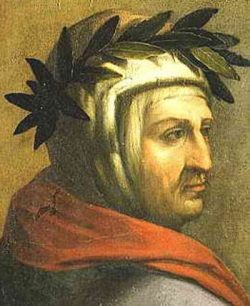#439 Kissing through a handkerchief
December 04th, 2018

Duets: Sonnets of Louise Labé and Guido Cavalcanti
by Edward Byrne
Vancouver: Talonbooks, 2018
$16.95 / 9781772011999
Reviewed by Andrew Parkin
*
 Canadian poet Edward Byrne’s book is described as “a translation” of sonnets of Louise Labé (1522-1566) and Guido Cavalcanti (circa 1255-1300). The poems published in this book are not sonnets in terms of the sonnet form itself with its fourteen lines, or sometimes two or three more, its strict rhyming, and its change of direction in the eighth or ninth lines. Byrne has adapted the original sonnets to make shorter poems, often cruder in thought as well as form than those of Labé (“la belle cordière” or “Lyonnaise” as she has been affectionately called). The elegance and sometimes rueful vision of love and philosophy in Cavalcanti’s sonnets and the love of life in the Lyonnaise are generally missing in Byrne’s verses. So what does Byrne offer in what I would call mainly nine line batches, more adaptations than translations?
Canadian poet Edward Byrne’s book is described as “a translation” of sonnets of Louise Labé (1522-1566) and Guido Cavalcanti (circa 1255-1300). The poems published in this book are not sonnets in terms of the sonnet form itself with its fourteen lines, or sometimes two or three more, its strict rhyming, and its change of direction in the eighth or ninth lines. Byrne has adapted the original sonnets to make shorter poems, often cruder in thought as well as form than those of Labé (“la belle cordière” or “Lyonnaise” as she has been affectionately called). The elegance and sometimes rueful vision of love and philosophy in Cavalcanti’s sonnets and the love of life in the Lyonnaise are generally missing in Byrne’s verses. So what does Byrne offer in what I would call mainly nine line batches, more adaptations than translations?
Byrne extracts certain phrases from the originals and translates them, cutting out what he doesn’t want to use, and often favours a harsh modernity of phrase and image not present in the original ancient poem to produce contemporary verses that some journalists would approvingly call “gritty.” The sonnet as a little song implies musicality in the verse, but as a good rebel Byrne usually abandons rhyme, so that it’s difficult to see his truncated poems as little songs. After all, contemporary pop musicians still use words with rhyme and strong rhythms. Moreover his lines often lack the metrical quality that makes for a decisive poetic line.
One finds in Byrne’s version of Cavalcanti’s sonnet 21 the maladroit attempt to make the Italian poet seem relevant to contemporary Canadians by using such phrases, not of course in the original, as “Didn’t you see him babe…” and “It was fuckin A out of nowhere…” (p. 81). Byrne can write such stuff of course in his own verse, but to offer this as a translation of the elegant, educated Guido Cavalcanti doesn’t work. In fact, born into a wealthy Florentine family, Cavalcanti was a friend of Dante, and also had a sophisticated poetic gift.

Detail of Six Tuscan Poets, by Giorgio Vasari, 1544. Cavalcanti is at far right, next to Dante, who is holding a book
Incidentally, Dante’s “Divine Comedy” has been translated by a Chinese Canadian poet, Lawrence Wong, who not only learned Italian but also lived in Italy for a year to attune his Italian to the task of translating this unique masterpiece. He translated from Dante’s original and kept to terza rima. A Stanford scholar of Chinese told me that Wong’s Dante would be the Chinese Dante for at least a hundred years.
Translation, though, has now become an ever growing site of contestation as well as a discipline taught in major universities around the world. I suppose this is one result of the globalization of business. In Cultures of Translation (Cambridge Scholars Publishing, 2008) Monika Gomille’s “Introduction” neatly sets out the shift in the meanings of the translation process: “…the aim of translation is no longer a product, i.e. the reproduction of a text in a foreign language, but a cultural function that establishes a continuing and dynamic relationship between texts and cultures…. It is a textual practice, a form of (re-) writing the contact between different cultures, on the one hand, and a performative act, on the other” (p. vii).
From my reading of Byrne, it seems that he has produced a textual practice of that sort rather than translation in the normal sense of the word. And this is his privilege to do; but I object to the notion that he has produced sonnets in translation.
Two examples of Byrne’s “sonnets” must suffice in a review: Cavalcanti’s fourteen line sonnet XXIII, “Io vidi li occhi dove Amor si mise” recounts the poet’s fear of the Love that makes him seem “noioso” (loathsome?) and which broke his heart “cor si divise” until the lady smiled “la donna rise.” A heavenly spirit came into his mind when the lady deigned to look at him. The spirit tells a truth about love, so that the poet sees the lady’s virtues as if he were in her heart, “si com’ io fosse nello suo cor giunto.” Byrne offers as his “translation” of the Cavalcanti sonnet these nine lines that radically change it:
Your eyes heartless love impoverish me
harsh noisy squint splits my resistance
and if you didn’t smile once in a while
my voice my guile would abandon me
and love would nail me to the door
with spikes of the imaginary
From above the corner of her mouth
the little wicked winged thought
climbs in my ear lugging the real (p. 80)
Cavalcanti’s introspection, broken heart, and then his insight into the lady’s heart and her virtues suggest a man made more thoughtful by his love for the lady. Byrne invents a more violent and resistant lover where neither lover nor lady have hearts and her glance at the end seems to hint at a malevolent Mona Lisa, whose ghost of a smile reaches the “I” of the poem with a rough put-down. Byrne as lover is not Cavalcanti as lover. To call this translation is really to put Byrne’s sentiments into verse and claim they are reflections of Cavalcanti; it is a cultural and textual practice that marks cultural differences.
*
Louise Labé, detail of an engraving, 1555
How does Byrne deal with la belle Lyonnaise? In sonnet 13, “Oh si j’estois en ce beau sein ravie,” Louise Labé wishes her lover would ravish her and she could live with him all this too brief life, “Euripe” itself, that stormy current between famous Greek islands, would crush them together rather than parting them. She wants her lover’s arms tight about her, as ivy entwining a tree, so that even death would be “de mon aise envieuse.” Her lover’s kiss would enable her spirit to fly away and know more joy in death than in life. Labé is conscious of the envy of others.
Byrne’s version cuts as usual the elegant yet tight form of this highly favoured sonnet but captures some of Labé’s ardent sensuality. Yet Byrne cannot resist putting in the word “Oedipal.” This Freudianism, aside from whether it’s relevant here, seems to me crassly out of place. It introduces into a purported translation a resonance to my mind unwanted. Interestingly, Byrne prints below his Oedipal version a second version lacking the Oedipus reference and introducing a reference to Europe — again absent from the original sonnet. What he does not do is put into either of his versions Labé’s striking image of Euripe. If he can footnote a second entire version of the poem, he could certainly place there a brief note on Euripe, an image clearly important for the Lyonnaise.
Byrne takes an original sonnet and uses it to express his own modernity. His translation of snatches of verse is insufficient. The book could more accurately be characterized as “cultural variations on themes from two poets.”
Stoneware bust of Louise Labé by Jean-Joseph Carriès, circa 1887. Los Angeles County Museum of Art
At the same time, Duets has a scholarly side to it. The Labé-derived poems are more faithful to the original in my view than is the case with the Cavalcanti material. Byrne includes a section of English versions of Rilke and Proust, verse by Foucault and Kristeva rendered in English, and he also footnotes Lacan — de rigueur in the UK and North America still, even though in France itself the kowtowing to “theory” has faded. As for Rilke in translation, Byrne does not mention Graham Good’s translations, which were published in Vancouver and have been reprinted. See Rilke’s Late Poetry: Duino Elegies The Sonnets to Orpheus selected Late Poems (Vancouver: Ronsdale: 2015) [4th printing]. Good benefitted from consultations with a number of scholars , including Marketa Goetz-Stankiewicz and the late, alas, Peter Loeffler. In the section “Pendant,” Byrne has English versions of five presumably French versions of Labé poems. Byrne’s scholarly side appears also in his “Notes on the Text.” In his note on the Rilke augmentations of Labé, Byrne’s honesty as a writer and teacher comes out with his use of the word “diminishment” (p. 103). And his honesty as a scholar and writer appears also in his account of other books he was unable to consult, because they had not yet appeared while he was working on his own book (pp. 101-102).
But he does not mention Anthony Mortimer’s translations and scholarly remarks in Complete Poems Guido Cavalcanti (One World Classics, 2010) or Marc Cirigliano’s earlier Guido Cavalcanti: The Complete Poems (Ithaca Press, 1992). Both books print the Italian and English texts on facing pages, a very useful bilingual practice. Byrne oddly makes no mention of another bilingual edition, David R. Slavitt’s The Metabolism of Desire: The Poetry of Guido Cavalcanti (Athabasca University Press, 2012). Slavitt translates sonnets into sonnets that rhyme, and concludes his succinct Preface by a telling remark: “What is essential in Cavalcanti’s poems is their lilt, their grace, their appealing dexterity” (p. ix). But Byrne’s verse avoids rhyme whenever possible and sometimes lacks musicality in his lines. Nor does Byrne mention David Anderson’s bilingual Pound’s Cavalcanti: An Edition of the Translations, Notes, and Essays (Princeton University press, 1983). And what about Pound and Cavalcanti? Byrne gives a concise and I think scrupulous account of his use of Pound’s work as well as mentioning his foray into Rossetti’s Cavalcanti.
What now? I would recommend Byrne’s book for discussion in departments of translation as well as Creative Writing because of its problematic nature, demonstrated by some of the points I have already raised here. The shifting of the sonnet from 14 or 14 + to a norm of 9 lines should make for fruitful discussion of what these 9 line strophes should be called.
As a reviewer, I would argue that such a shift warrants a different name for such verse. A famous translation that is only partial translation, but which seems like original poetry, is Fitzgerald’s famous Rubaiyat, whose ambiguity in this respect Byrne’s work shares even though Byrne’s book is totally different from Fitzgerald’s best-selling work. So Byrne supplies stanzas of nine unrhymed lines of partly original verse. The result has served to remind contemporary readers of the existence of Cavalcanti, of whom they may well have heard, and of Louise Labé, whose work may have been unknown to them, if they had missed out on her. In my view, readers interested in her should read D.L. Baker’s Louise Labé: Complete Poetry and Prose. A Bilingual Edition (University of Chicago Press, 2006). This has a very good critical introduction with Labé’s prose translated by Baker and poetry translated by Annie Finch.
I shall now offer some responses to Byrne’s work as partly original verse rather than as translation. In his rendering/ adaptation of both these sonneteers, Byrne avoids punctuation in the manner of some of the 1960s and 1970s poets and tries not to rhyme. Seamus Heaney and other major Anglo-Irish poets didn’t fall into that manner. In the tercets and couplets that recall Labé, capital letters are used, often to begin a tercet, but more seriously some of the poems are not successful, despite material used by their distinguished springboard poets. On the positive side, Byrne’s version of Labé’s sonnet 9 works very well and ends with this telling perception: “And if my poor enamoured being/ can never have such sweetness in truth/ let it have these truths these nightly lies” (p.12).
His version of sonnet 4 starts with what seems like “une ligne donnée,” a line that seems to appear straight from the Muse and which the poet must find companions for: “Since love first burnt my breast with fire.”
Byrne continues to produce a lyric imbued with a fine defiance (p. 8). There are many successful lyrics in this book and sometimes we find in a not totally successful batch of lines a gem which gleams. But the Julia Kristeva poem strikes me as just a lame thing limping on terminological crutches (p. 15).
The section entitled “The Rilke Versions” to my mind contains some of Byrne’s best verses. But my favourite in this book is based on Cavalcanti sonnet 17, “Because I beg for her attention.” Byrne ends with some of Cavalcanti’s complexity expressed with powerful simplicity:
My sad and anxious soul sits weeping
over the sighs gathered in my heart
Rain drenched they flee when you arrive
to theorize my heart’s demise (p. 82).
The Anglo-Welsh poet, R.S. Thomas, once called translation a kiss through a handkerchief. Byrne has given his two poets somewhat abrupt, brief translations. I figure he gave them a peck on both cheeks.
*
Andrew Parkin was educated in Birmingham at school, and in the RAF Russian programme. After that he studied English at Cambridge and drama for a Ph.D. at Bristol. He emigrated to Canada and taught at UBC before going to the Chinese University of Hong Kong where, with the Chinese Canadian poet and translator Laurence Wong, he read at the Canadian Consulate and elsewhere on campuses. He retired to Paris and read for the Spring Poetry Festival there and in the “Poets Live” series, before returning to Vancouver with his French wife in 2015. He recently read with Jessica Li from his bilingual Star With a Thousand Moons (Victoria: Ekstasis) in the University of Regina and a few weeks later at York University, Ontario. Meanwhile he is completing a trilogy of novels about counter-terrorism.
*
The Ormsby Review. More Books. More Reviews. More Often.
Editor/Designer/Writer: Richard Mackie
Publisher/Writer: Alan Twigg
The Ormsby Review is a journal service for serious coverage of B.C. books and authors, hosted by Simon Fraser University. The Advisory Board consists of Jean Barman, Robin Fisher, Cole Harris, Wade Davis, Hugh Johnston, Patricia Roy, David Stouck, and Graeme Wynn. Scholarly Patron: SFU Graduate Liberal Studies. Honorary Patron: Yosef Wosk. As of September, 2018, Provincial Government Patron: Creative BC
“Only connect.” – E.M. Forster






Leave a Reply